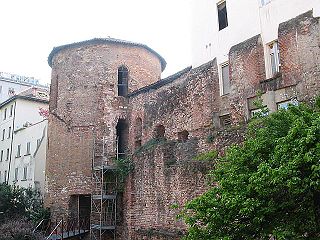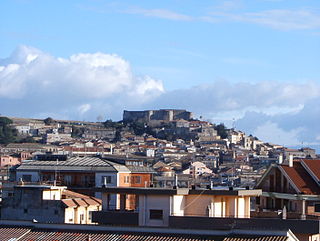
Abydos was an ancient city and bishopric in Mysia. It was located at the Nara Burnu promontory on the Asian coast of the Hellespont, opposite the ancient city of Sestos, and near the city of Çanakkale in Turkey. Abydos was founded in c. 670 BC at the most narrow point in the straits, and thus was one of the main crossing points between Europe and Asia, until its replacement by the crossing between Lampsacus and Kallipolis in the 13th century, and the abandonment of Abydos in the early 14th century.

Niccolò di Bernardo dei Machiavelli, was an Italian diplomat, author, philosopher and historian who lived during the Renaissance. He is best known for his political treatise The Prince, written around 1513 but not published until 1532, five years after his death. He has often been called the father of modern political philosophy and political science.

Mediolanum, the ancient city where Milan now stands, was originally an Insubrian city, but afterwards became an important Roman city in northern Italy. The city was settled by the Insubres around 600 BC, conquered by the Romans in 222 BC, and developed into a key centre of Western Christianity and informal capital of the Western Roman Empire. It declined under the ravages of the Gothic War, its capture by the Lombards in 569, and their decision to make Ticinum the capital of their Kingdom of Italy.

Colonies in antiquity were post-Iron Age city-states founded from a mother-city, not from a territory-at-large. Bonds between a colony and its metropolis remained often close, and took specific forms during the period of classical antiquity. Generally, colonies founded by the ancient Phoenicians, Carthage, Rome, Alexander the Great and his successors remained tied to their metropolis, but Greek colonies of the Archaic and Classical eras were sovereign and self-governing from their inception. While Greek colonies were often founded to solve social unrest in the mother-city, by expelling a part of the population, Hellenistic, Roman, Carthaginian, and Han Chinese colonies were used for trade, expansion and empire-building.

Phocaea or Phokaia was an ancient Ionian Greek city on the western coast of Anatolia. Greek colonists from Phocaea founded the colony of Massalia in 600 BC, Emporion in 575 BC and Elea in 540 BC.

Utica was an ancient Phoenician and Carthaginian city located near the outflow of the Medjerda River into the Mediterranean, between Carthage in the south and Hippo Diarrhytus in the north. It is traditionally considered to be the first colony to have been founded by the Phoenicians in North Africa. After Carthage's loss to Rome in the Punic Wars, Utica was an important Roman colony for seven centuries.

Vibo Valentia is a city and comune (municipality) in the Calabria region of Southern Italy, near the Tyrrhenian Sea. It is the capital of the province of Vibo Valentia, and is an agricultural, commercial and tourist center. There are also several large manufacturing industries, including the tuna district of Maierato. Very important for the local economy is Vibo Marina's harbour.

Arpino is a comune (municipality) in the province of Frosinone, in the Latin Valley, region of Lazio in central Italy, about 100 km SE of Rome. Its Roman name was Arpinum. The town produced two consuls of the Roman republic: Gaius Marius and Marcus Tullius Cicero.

Morgantina is an archaeological site in east central Sicily, southern Italy. It is sixty kilometres from the coast of the Ionian Sea, in the province of Enna. The closest modern town is Aidone, two kilometres southwest of the site. The site consists of a two-kilometre long ridge running southwest-northeast, known as Serra Orlando, and a neighboring hill at the northeast called Cittadella. Morgantina was inhabited in several periods. The earliest major settlement was made at Cittadella and lasted from about 1000/900 to about 450 BCE. The other major settlement was located on Serra Orlando, and existed from about 450 BCE to about 50 CE. Morgantina has been the subject of archaeological investigation since the early 20th century.

Larissa or Larisa (Λάρισα) Phrikonis, also known as Larisa on the Hermos, was a city in the region of Aeolis in western Asia Minor. It has been identified with an archaeological site excavated in the early 20th century on a hilltop next to the village of Buruncuk, in the vicinity of Menemen, ca. 30 km north of İzmir, although the identification has sometimes been challenged. The hill overlooks the Gediz River, known in antiquity as the Hermos, which here passes through a fertile plain formed by alluvial soil carried from the Anatolian inland.

Mainake, Menace was an ancient Greek settlement lying in the southeast of Spain, according to the Greek geographer and historian Strabo (3,4,2) and Pausanias of Damascus. Pausanias adds that it was a colony of the Greek city of Massalia. Maria Eugenia Aubet locates it at the site of modern Málaga. The first colonial settlement in the area, dating from the late 8th century BC, was made by seafaring Phoenicians from Tyre, Lebanon, on an islet in the estuary of the Guadalhorce River at Cerro del Villar.
Amyzon in Caria was an ancient city 30 km south of modern Koçarlı.
Faustinopolis, also Colonia Faustinopolis and Halala, was an ancient city in the south of Cappadocia, about 20 km south of Tyana. It was named after the empress Faustina, the wife of Marcus Aurelius, who died there in a village, which her husband, by establishing a colony in it, raised to the rank of a town under the name of Faustinopolis. Hierocles assigns the place to Cappadocia Secunda, and it is mentioned also in the Antonine and Jerusalem Itineraries. The town was close to the defiles of the Cilician Gates, and was likely situated at modern-day Başmakçı, Niğde Province, Turkey. Following the Muslim conquests and the subsequent Arab raids, the site was abandoned for the nearby fortress of Loulon.
Crithote or Krithote was an ancient Greek city located in Thrace, located in the region of the Thracian Chersonesos. It was on the Hellespont north of Gallipolis, and was an Athenian colony founded by Miltiades. It is cited in the Periplus of Pseudo-Scylax among the cities of the Thracian Chersonesos: Aegospotami, Cressa, Crithote, and Pactya.
Madytus or Madytos was a Greek city and port of ancient Thrace, located in the region of the Thracian Chersonesos, nearly opposite to Abydos.

Isinda was a town of ancient Pisidia.
Bargasa or Pargasa (Πάργασα) was a city of ancient Caria. It was a polis (city-state) and a member of the Delian League. There are also coins of Bargasa with the epigraph Βαργασηνῶν. It is mentioned by Strabo, who, after speaking of Cnidus, says, "then Ceramus and Bargasa, small places above the sea."
Paesus or Paisos, in the Trojan Battle Order in Homer's Iliad called Apaesus or Apaisos (Ἀπαισός), was a town and polis (city-state) on the coast of the ancient Troad, at the entrance of the Propontis, between Lampsacus and Parium. The city of Apaššawa from the Hittite documents is identified as Paesus. In the Iliad, Amphius, son of Selagus, was said to be from Paesus. At one period it received colonists from Miletus. It suffered Persian occupation during the Ionian Revolt. In Strabo's time the town was destroyed, and its inhabitants had transferred themselves to Lampsacus, which was likewise a Milesian colony. The town derived its name from the small river Paesus, on which it was situated. It was a member of the Delian League and appears in tribute lists of Athens between 453/2 and 430/29 BCE.
Artace or Artake was a town of ancient Mysia, near Cyzicus. It was a Milesian colony. It was a seaport, and on the same peninsula on which Cyzicus stood, and about 40 stadia from it. in Greek mythology, Artace is mentioned as the place where the argonauts changed the stone anchor of the Argo for a larger one. Artace was burnt, together with Proconnesus, during the Ionian Revolt, in the reign of Darius I. Probably it was not rebuilt for quite some time, for Strabo in the 1st century does not mention it among the Mysian towns: but he speaks of a wooded mountain of the name, with an island of the same name near to it, the same which Pliny the Elder calls Artacaeum. Timosthenes, quoted by Stephanus of Byzantium, also gives the name Artace or Artake to a mountain, and to a small island, one stadium from the land. In the time of Procopius, Artace had been rebuilt, and was a suburb of Cyzicus.











